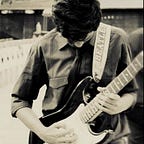How Well Do We Perceive Maps?
Spatial representations can help us perceive geographical phenomena.
The reassurance that information can be reliably perceived is an obligatory condition whenever visual techniques are used for data analysis. So, does it imply that what we see in the visualization — the visual effect, is close to any underlying statistical effect that we’re interested in?
It is an inherent fact that the perceived effect created by the visualization might not match the statistical effect obtained from calculations on the data. Based on the choice of visual encoding, it is possible that a given visualization might exaggerate certain structures over others. Moreover, an increase in complexity makes it even more challenging to identify graphical phenomena.
To illustrate, observe the two scatterplots in the figures below:
Which of the two scatterplots in each figure, is likely to have a higher correlation coefficient?
Just a quick glance at Figure 1 should be enough to tell you that the scatterplot on the left-hand side is more correlated.
But when you look at Figure 2, you’ll find that it is now much harder to judge purely based on visual characteristics of the graph.
Here, it is the graph on the right (r = 0.35) that is more correlated. While the scatterplot on the left had an almost identical correlation coefficient value (r = 0.3), it is interesting to note that in both figures, the difference in correlation coefficients was exactly the same (In figure 1, r = 1.0 and 0.95).
There are many studies that demonstrate how the perception of statistical effects varies with the intensity of correlation and type of visualization. In such cases, it is easier to compare similar-looking data sets using statistical techniques. However, to measure visual similarity, Wickham et al.’s line-up protocol can be used to provide some credibility to data plots. A line-up test is a graphical inference method where the actual plot is placed among a group of decoy plots, which are constructed under the premise that no significant variations exist in the data. An impartial observer is asked to identify the real plot from the group. If the observer fails to do so, then the plot cannot be considered noticeably different.
Making visual inferences from mapped geospatial data
Tobler’s First Law of Geography
Everything is related to everything else, but near things are more related than distant things.
Roger Beecham et al. believed that the same graphical inference methods could be adapted to study spatial phenomena in choropleth maps. Before we see how they conducted the experiment, let us look at some key concepts and terminology:
Choropleth maps — also known as thematic maps, that are popularly used to show spatial phenomena. It helps us understand the role of space in the phenomena. Eg. Crime rates.
Spatial autocorrelation, or association — the term used to describe how close the objects are in geographical space. Moran’s I is the measure used to quantify the extent of spatial autocorrelation and is a direct translation of Pearson’s correlation coefficient.
Irregularity — this concept is used to characterize the variation in size, shape and visual complexity of the spatial units. For this experiment, there are three levels of irregularity: irregular real, regular real and regular grid.
The researchers re-implemented a procedure previously conducted in a similar study to measure graphical inference. They modified their experiment to focus on how performance varied with respect to irregularity of spatial units and intensity of autocorrelation structure.
Here, another concept known as Just Noticeable Difference (JND)—which is the smallest difference necessary to perceive stimuli as being different, is introduced with the intention to measure the impact that the visual effects have on perception.
Each participant was shown two choropleth maps side-by-side with different values of Moran’s I and asked to select the one they perceive to have a greater spatial autocorrelation structure. Through the use of Amazon Mechanical Turk, the team was able to collect data from 361 workers.
Implications for lineup designs?
Now we can clearly see, from the result of the data analysis, the influence of autocorrelation (I) and geometric irregularity:
- JND decreases with the intensity of autocorrelation, which indicates that map lineup designs become more sensitive or exaggerated where phenomena are very spatially autocorrelated.
- JND increases with geometric irregularity, and that tells us that map lineup designs will be toned down and prone to vary.
Conclusion
The primary goal of this study was to provide empirical evidence to inform the use of line-up tests in choropleth maps. The researchers replicated an established experimental procedure for measuring JND in nonspatial correlation — that is the minimum difference in correlation required to be visually observable in approximately 3 out of 4 cases. As autocorrelation increases, the difference in effect required to discriminate that structure decreases. In the cases of irregular geography, JNDs tend to become wider and have greater between-participant variation.
This post is based on the following paper:
- Roger Beecham, Jason Dykes, Wouter Meulemans, Aidan Slingsby, Cagatay Turkay, Jo Wood. Map LineUps: effects of spatial structure on graphical inference. IEEE Trans. Visualization and Computer Graphics, 2017. [PDF]
